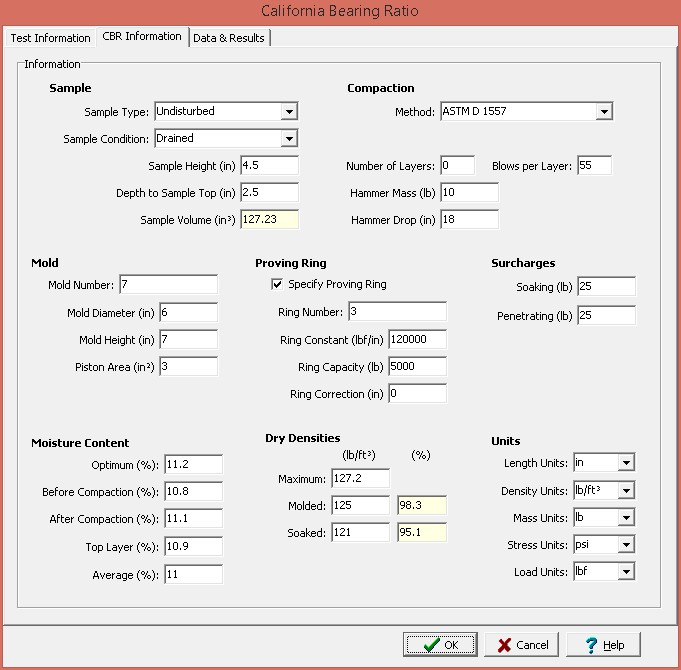|
<< Click to Display Table of Contents >> CBR Information Tab |
  
|
|
<< Click to Display Table of Contents >> CBR Information Tab |
  
|
This tab is used to specify the CBR information for the specimens.

The following can be entered and displayed on this tab:
Sample
Sample Type: This is used to select the type of sample. It can be either disturbed or undisturbed.
Sample Condition: This is used to select the condition of the sample. It can be either drained, undrained, soaked, or unsoaked.
Sample Height: This is used to specify the sample
Depth to Sample Top: This is used to specify the depth to top of the sample in the mold.
Sample Volume: This is the calculated volume of the sample using the sample height and mold diameter.
Compaction
Method: This is used to select the compaction method. It can be either ASTM D698, ASTM D1557, or Other. If it is Other then the other method can be specified.
Number of Layers: This is used to specify the number of layers.
Blows per Layer: This is used to specify the blows per layer used for compaction.
Hammer Mass: This is used to specify the hammer mass used for compaction.
Hammer Drop: This is used to specify the hammer drop used for compaction.
Mold
Mold Number: This is used to specify the mold number.
Mold Diameter: This is used to specify the mold diameter.
Mold Height: This is used to specify the mold height.
Piston Area: This is used to specify the piston area.
Proving Ring
Specify Proving Ring: Check this box to specify the proving ring. Some CBR machines use a proving ring instead of a load cell to measure the load.
Ring Number: This is used to specify the ring number.
Ring Constant: This is used to specify the ring constant. When using a proving ring, the load is calculated by multiplying the reading by the ring constant.
Ring Capacity: This is used to specify the ring capacity.
Ring Correction: This is used to specify the ring correction. In some cases the zero reading may not be equivalent to a zero load. This correction is subtracted from the reading before it is converted to a load using the ring constant.
Surcharges
Soaking: This used to specify the surcharge weight used during soaking.
Penetrating: This is used to specify the surcharge weight used during penetration.
Moisture Content
Optimum: This is used to specify the optimum moisture content.
Before Compaction: This is used to specify the moisture content before compaction.
After Compaction: This is used to specify the moisture content after compaction.
Top Layer: This is used to specify the moisture content in the top 1 in. (25.4 mm) layer after soaking.
Average: This is the average moisture content after soaking.
Dry Densities
Maximum: This is used to specify the maximum dry density.
Molded: This is used to specify the molded (before soaking) dry density. If specified the percent of maximum dry density is shown.
Soaked: This is used to specify the soaked dry density. If specified the percent of maximum dry density is shown.
Units
Length Units: This is used to select the units for length.
Density Units: This is used to select the units for density.
Mass Units: This is used to select the units for mass.
Stress Units: This is used to select the units for stress.
Load Units: This is used to select the units for load.